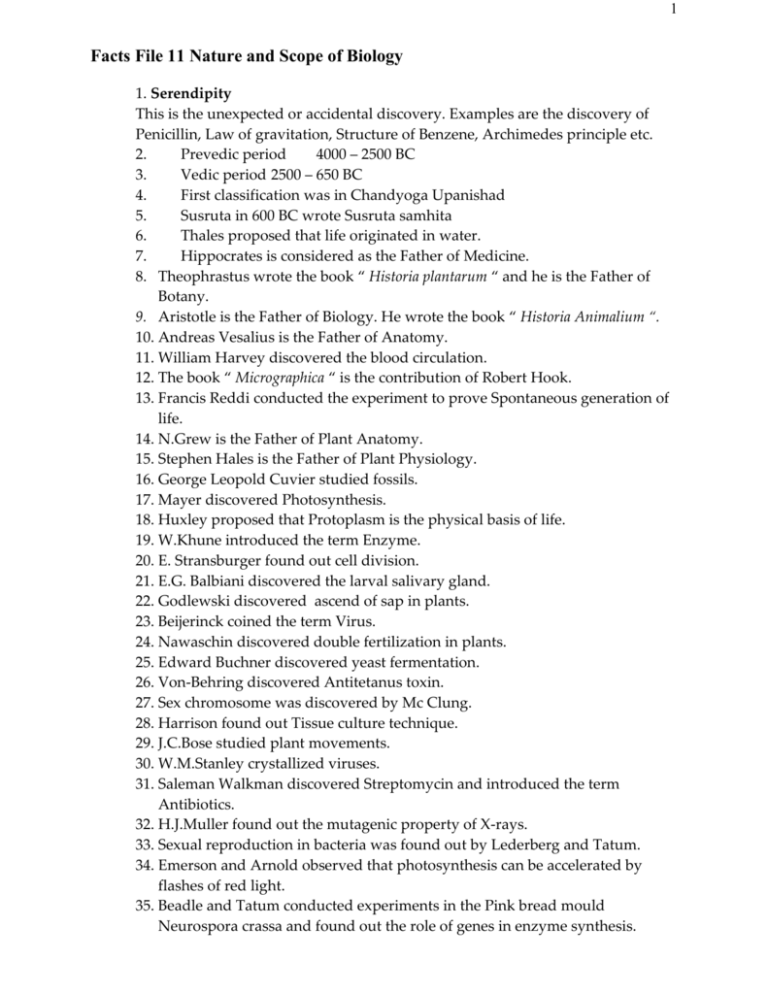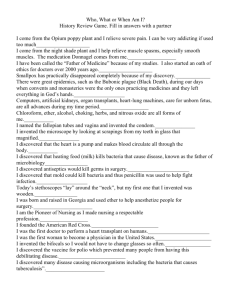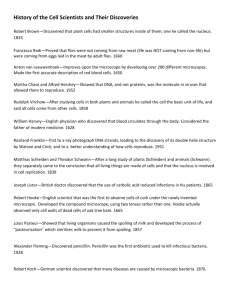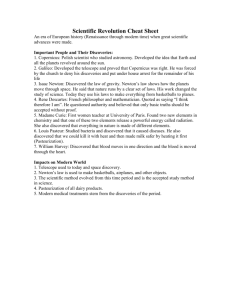CHAPTER 1 NATURE AND SCOPE OF BIOLOGY , EVOLUTION
advertisement

1 Facts File 11 Nature and Scope of Biology 1. Serendipity This is the unexpected or accidental discovery. Examples are the discovery of Penicillin, Law of gravitation, Structure of Benzene, Archimedes principle etc. 2. Prevedic period 4000 – 2500 BC 3. Vedic period 2500 – 650 BC 4. First classification was in Chandyoga Upanishad 5. Susruta in 600 BC wrote Susruta samhita 6. Thales proposed that life originated in water. 7. Hippocrates is considered as the Father of Medicine. 8. Theophrastus wrote the book “ Historia plantarum “ and he is the Father of Botany. 9. Aristotle is the Father of Biology. He wrote the book “ Historia Animalium “. 10. Andreas Vesalius is the Father of Anatomy. 11. William Harvey discovered the blood circulation. 12. The book “ Micrographica “ is the contribution of Robert Hook. 13. Francis Reddi conducted the experiment to prove Spontaneous generation of life. 14. N.Grew is the Father of Plant Anatomy. 15. Stephen Hales is the Father of Plant Physiology. 16. George Leopold Cuvier studied fossils. 17. Mayer discovered Photosynthesis. 18. Huxley proposed that Protoplasm is the physical basis of life. 19. W.Khune introduced the term Enzyme. 20. E. Stransburger found out cell division. 21. E.G. Balbiani discovered the larval salivary gland. 22. Godlewski discovered ascend of sap in plants. 23. Beijerinck coined the term Virus. 24. Nawaschin discovered double fertilization in plants. 25. Edward Buchner discovered yeast fermentation. 26. Von-Behring discovered Antitetanus toxin. 27. Sex chromosome was discovered by Mc Clung. 28. Harrison found out Tissue culture technique. 29. J.C.Bose studied plant movements. 30. W.M.Stanley crystallized viruses. 31. Saleman Walkman discovered Streptomycin and introduced the term Antibiotics. 32. H.J.Muller found out the mutagenic property of X-rays. 33. Sexual reproduction in bacteria was found out by Lederberg and Tatum. 34. Emerson and Arnold observed that photosynthesis can be accelerated by flashes of red light. 35. Beadle and Tatum conducted experiments in the Pink bread mould Neurospora crassa and found out the role of genes in enzyme synthesis. 2 36. Archibald Garrod got nobel prize for his work on the Inborn errors of metabolism in man. 37. Operon concept was developed by Jacob and Monod. 38. Khorana shared nobel prize with Robert.w.Holley and Marshal Nirenberg for the synthesis of artificial gene. 39. Stanley Cohen, Herbert Boyer discovered the Recombinant DNA technique. 40. Arber, Smith, Nathans discovered Restriction endonuclese. 41. Mc Clintock Barbara discovered Transposones or Jumping genes in Maize. 42. Ian Wilmut created Dolly in 1996 through animal cloning. 43. BRANCHES OF BIOLOGY 1. Phenetics Numerical taxonomy based on overall similarities of organisms and also called Adansonian taxonomy. 2. Cladistics Classification based on Phylogenetic relations. 3. Eugenics Improvement of human race. 4. Euthenics Improvement of better living conditions. 5. Euphenics Improvement of body conditions, treatment of diseases. 6. Ethnology Study of different races of man based on distribution, culture etc. 7. Cosmogony Study of origin of universe. 8. Exobiology Study of possibility of life in the outer space. 9. Cybernetics Deals with Neurobiology and Endocrinology. 10. Limnology Study of fresh water ecosystems. 11. Etiology Study of causes of diseases. 12. Phycology Study of algae. 13. Agrostology Study of grasses. 14. Palynology Study of pollen grains. 15. Malacology Study of Molluscs. 16. Ichthyology Study of Fishes. 17. Herpetology Study of Reptiles. 18. Serpentology Study of Snakes. 19. Saurology Study of Lizards. 20. Ornithology Study of Birds. 21. Angiology Study of Blood vascular system. 22. Karyology Study of Nucleus. 23. Chondrology Study of Cartilages. 24. Dysteleology Study of Vestigeal organs. 25. Myology Study of Muscles. 26. Kalogy Study of Human beauty. 27. Oncology Study of cancer. 28. Osteology Study of Bones. 29. Nanotechnology Technology of ultra small machines smaller than living molecules. 3 44. SCIENCE OF EXCEPTIONS 1. Rhizopora and Sonneratia are mangrove plants and their roots are negatively geotropic. 2. Leaves of monocot plants like Smilax, Colocasia show reticular venation. 3. Leaves of dicots like Calophyllum, Corymbium show parallel venation. 4. Cuscuta lacks cotyledons. 5. Blood of shark is colour less. 6. Duckbilled platypus ( Ornithorhynchus ) and Spiny anteater ( Echidna ) are egg laying mammals. 7. Protopterus and Lepidosiren possess lungs. 8. Ostrich, Kiwi etc are Ratitae or flight less birds. 9. Honey bee males are haploid ( 16 chromosomes ) and develop through parthenogenesis. 45. BTX toxin is Boutulinum toxin produced by Clostridium boutilinum. It is used as biological weapon. 46. Ricin, Trithecane, Anthrax etc are used as biological weapons in Bio war. 47. Amniocentesis is used to identify the sex of foetus. It uses study of chromosomes. 48. Silviculture is the study of forest trees. 49. Occupational therapy is the treatment of mentally and physically retarded people. 50. Sericulture is the rearing of Silkworm. 51. Apiculture is the study of Honey bee. 52. Aquaculture is the study of aquatic animals. 53. Pisciculture is the study of fishes. 54. Biometrics is the biostatistics. 55. Cryobiology is the study of life at low temperature. 56. Ethanobotany deals with the relationship between primitive people and plants. 57. Genecology is the study of the genetic diversity with in a species. 58. Spermology is the study of seeds. 59. Taphonomy is the study of the conditions required for fossilization. 60. Teratology is study of the abnormal embryonic development. 61. Homeostatic system 1. Body temperature regulation, Action of hormones like Thyroxin, Insulin, Glucagon, Renin – Angiotensin system etc. 62. Organizer is the part of enbryo which induce another part for differentiation. 63. Haemocyanin is present in Crustacea, Octopus, Squid. 64. Short term adaptations 1. Tanning – darkening of skin in sunlight. 2. Hibernation and Aestivation. 4 3. Dormancy in seeds. 4. Multilayered cork in plants. 5. Mangrove plant Poa alpina germinate with in the seed and it remains attached to parent body and shows Viviparity. 65. Long term adaptations 1. Claw of birds, Beak of birds, Tail of Kangaroo. 2. Absence of stomata in submerged plants, Extensive roots in Xerophytes. 3. Curved claws in Wall lizard, Pneumatic bones of birds. 4. Night blooming flowers are white and Scented. 5. Mouth parts of Insects for feeding . 6. Humming bird fly and feed nectar. 7. Orchid flower ( Ophrys muscifera ) resembles female wasp. 8. Aquatic plants like Lymnophilia and Heterophylla show Heterophylly Life span of some animals 1. Shortest life span – May fly – one day 2. Longest life span – Sequoia Red wood tree – 3000 – 4000 years 3. Pepal life span is 2000 – 3000 years Homologous organs Same origin but different function 1. Pentadactyle limb of vertebrates – Limb of frog, Man, Wing of bat, Flippers of Whale, Wing of bat. 2. Insect mouthparts 3. Thorn of Bougain villea and Tendril of Passiflora ( Passion flower ) Connecting Links Organism showing characters of two different groups. 1. Euglena – Plants and Animals 2. Peripatus – Arthropoda and Annelida. 3. Lung fish – Fishes and Amphibia. 4. Egg laying mammals – Reptiles and Mammals Analogous organs Different origin but same function 1. Wing of insect and bird 2. Fin of fish and Flipper of whale. 3. Octopus eye and vertebrate eye. 4. Leaves and Cladode ( Ruscus ) 5. Tuberous root and potato Vestigeal organs Organs which are non functional but once functional in the ancestors 1. Tail bone Coccyx 2. Canine and wisdom teeth 3. Plica semilunaris (nictitating membrane ) 4. Auricular muscles – ear pinna muscles 5. Caecum and Vermiform appendix. 6. Vestigeal Pelvic girdle of Green land Whale. 7. Reduced pelvic girdle and limbs of Python and Boa 8. Splint bones of Horse 9. 90 Vestigeal organs are present in man 5 66. Atavism – Reversion – Reappearance of ancestral characters. Egs. Hairy Body, additional mammae, power to move ear pinna, large canines. 67. Recapitulation law was put forwarded by Von Baer. It was later called “ Biogenetic law of Haeckel. 68. Igneous rocks Rocks formed by the solidification of hot earth. 69. Magma Molten rock below the earth. 70. Shale Fine grained laminated rock. 71. Metamorphic rock Marble, Granite. 72. Coprolite Fossils of foecal pellets. 73. Impressions Archaeopteryx. 74. Fossil parks of India Fossil forest ( MP ), Rajmahal Hill ( Bihar ) Old coal forming forest ( Orissa ) National fossil park ( Thiruvakkarai Tamil nadu ). 75. Missing links Archaeopteryx lithographica ( Lizard bird ) 75. Eohippus First horse It is called “ Dawn Horse “. 76. Mesohippus Intermediate horse. It was a ruminating horse. 77. Equus Modern horse. 78. Discontinuous distribution – It is the distribution of animals here and there in the earth. Alligator South America, East America and China. Peripatus Nepal, Burma, Sri Lanka. Ratitae birds Australia, Newzealand Opposum America Kiwi Newzealand Kangaroo Australia LIVING FOSSILS – Primitive animals showing no trace of evolution. Echdina, Platypus, Sphenodon, Limulus ( King crab ), Peripatus, Neopilia ( Segmented molluscs ). 79. Industrial melanism A phenomenon in which the body colour of the Peppered moth Biston betularia ( light coloured ) changed in to dark and the new species Biston carbonaria evolved. It is an example of natural selection occurred in England folloing Industrial revolution. 80. Retrogressive evolution. It is exhibited by Tapeworm and Wingless insects. 81. Divergent evolution – It is called Adaptive radiation. Placental mammals, Homologous organs etc are examples of divergent evolution. 82. Parallel evolution - Running habit of deer and horse. Burrowing habit of Placental mole and Marsupial mole. 83. Microevolution – Example is Industrial melanism. 84. Monophyletic origin – Origin from a common ancestor. Example is origin of vertebrates from Ostracoderms. 85. Polyphyletic origin – Origin from different forms. 6 86. Leonardo da Vinci – Father of Palaentology. 87. Giovanni Avduina – Constructed Geological time scale in 1760. 88. Latimaria – Oldest living fish. Caught on Dec. 1938 from the east cost of South Africa. Belongs to the group Crossopterygia. It is considered as the ancestor of land vertebrates. 89. Zoogeography – It is the study of the distribution of animals. 90. Buffon – Father of Evolution. 7 UNIT 2 SYSTEMATICS 1.Theophrastus Father of Botany 2. John Ray Introduced the term Species. 3. Carolus Linnaeus Father of taxonomy. His book is ‘Species plantarum ‘ 4. System naturae Book written by Linnaeus for the classification of animals. 5. Trinomial nomenclature Three names are given to an animal – Generic, Specific and Sub specific. Eg. Homo sapiens sapiens. 6. ICBN International code of Botanical nomenclature. 7. ICZN International code of Zoological nomenclature. 8. ICBN International code of Bacteriology nomenclature. 9. ICVN International code of Viral nomenclature. 10. ICNCP International code of nomenclature for cultivated plants. Classification systems 1. Artificial classification It considers one or two characters for classification. It is a change from Aristotle to Linnaeus classification. 2. Sexual system It was proposed by Linnaeus. Reproductive characters are considering. 3. Natural system It includes all relationships of plants. It was suggested by George Bentham and Joseph Dalton Hooker. 4. Cladistics or Phylogenic It considers the evolutionary sequence and generic relation of organisms. 5. Whittaker’s system It is the five kingdom classification. MONERA Cyanobacteria and Archebacteria 1. Xanthomonas Parasitic 2. Pseudomonas Saprophytic 3. Rhizobium Symbiotic 4. Cyanobacteria Photoautotroph 5. Chemoautotrophs Nitrosomonas, Nitrobactor. 6. Nitrogen fixers - Azotobacter Archaebacteria Thermoplasma acidophilum Halophiles Bacteria lives in high salt concentration. Thermoacidophiles Bacteria lives in high temperature and acidic medium Eubacteria True bacteria like Actinomycetes and Cyanobacteria Forms of bacteria Bacillus Rod shaped Coccus Spherical Spirillum Spiral Vibrio Coma shaped It lives in high salt concentration and can tolerate high temperature around 80 degree. It can also survive in acidic medium. 8 Cyanobacteria or Blue green algae These are gram negative bacteria and are photosynthetic. Classification based on the structure. 1. Single celled Eg. Synechococcus. 2. Colonial Eg. Aphanocapsa. 3. Filamentous Egs. Nostoc, Anabaena, Oscillatoria. 4. Nitrogen fixers Nostoc, Aulosira. 5. Heterocysts These are nitrogen fixing cells of Nostoc. 6. Spirulina Bluegreen algae used to produce SCP. It is rich in beta carotene, a precursor of vitamin A.






